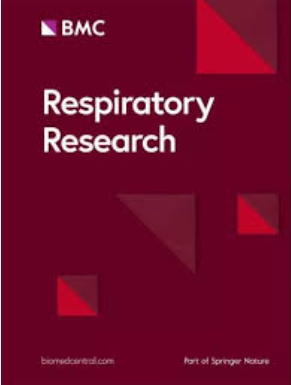对免疫检查点阻断疗法后立即接受后续治疗的患者中抗肿瘤疗法诱发的间质性肺病进行泛癌症评估
IF 4.7
2区 医学
Q1 RESPIRATORY SYSTEM
引用次数: 0
摘要
药物诱发间质性肺病(DIILD)是任何抗肿瘤药物都可能诱发的一种严重不良反应。癌症患者在接受免疫检查点抑制剂(ICIs)治疗后是否会有更高的DIILD风险尚不清楚。本研究回顾性地评估了在最后一次服用 ICIs 后 6 个月内接受 ICI 后抗肿瘤治疗的连续癌症患者中 DIILD 的累积发生率。此外,还有一个单独的对照组,由55名接受多西他赛治疗、对ICI不敏感的非小细胞肺癌(NSCLC)患者组成。在接受 ICIs 治疗的 552 例患者中,有 186 例符合纳入标准。这些患者主要是肺癌、肾癌/泌尿道癌或胃肠道癌患者。整个队列在3个月和6个月时的DIILD累积发生率分别为4.9%(95%置信区间[CI] 2.4%-8.7%)和7.2%(95% CI 4.0%-11.5%)。肺癌患者的DIILD累积发生率最高,3个月时为9.8%(95% 置信区间 [CI]:4.3%-18.0%),6个月时为14.2%(95% 置信区间 [CI]:7.3%-23.3%)。在这11名肺癌患者中,有6人(54.5%)的DIILD是由多西他赛引起的。匹配后,ICI 后 NSCLC 患者中多西他赛诱发 ILD 的累积发生率高于 ICI 未治疗患者:3个月时为13.0% (95% CI 3.3%-29.7%) vs 4.3% (95% CI 0.3%-18.2%) ;6个月时为21.7% (95% CI 7.9%-39.9%) vs 4.3% (95% CI 0.3%-18.2%) 。然而,这些差异并不显著(危险比,5.37;95% CI 0.64-45.33;Fine-Gray P = .12)。肺癌患者在接受 ICI 治疗后的后续治疗方案中发生 DIILD 的风险很高。NSCLC患者是否容易因之前的ICI而增加多西他赛诱发ILD的风险,还需要进一步研究。本文章由计算机程序翻译,如有差异,请以英文原文为准。
Pan-cancer assessment of antineoplastic therapy-induced interstitial lung disease in patients receiving subsequent therapy immediately following immune checkpoint blockade therapy
Drug-induced interstitial lung disease (DIILD) is a serious adverse event potentially induced by any antineoplastic agent. Whether cancer patients are predisposed to a higher risk of DIILD after receiving immune checkpoint inhibitors (ICIs) is unknown. This study retrospectively assessed the cumulative incidence of DIILD in consecutive cancer patients who received post-ICI antineoplastic treatment within 6 months from the final dose of ICIs. There was also a separate control cohort of 55 ICI-naïve patients with non-small cell lung cancer (NSCLC) who received docetaxel. Of 552 patients who received ICIs, 186 met the inclusion criteria. The cohort predominantly comprised patients with cancer of the lung, kidney/urinary tract, or gastrointestinal tract. The cumulative incidence of DIILD in the entire cohort at 3 and 6 months was 4.9% (95% confidence interval [CI] 2.4%–8.7%) and 7.2% (95% CI 4.0%–11.5%), respectively. There were significant differences according to cancer type (Gray’s test, P = .04), with the highest cumulative incidence of DIILD in patients with lung cancer being 9.8% (95% CI 4.3%–18.0%) at 3 months and 14.2% (95% CI 7.3%–23.3%) at 6 months. DIILD was caused by docetaxel in six of these 11 lung cancer patients (54.5%). After matching, the cumulative incidence of docetaxel-induced ILD in patients with NSCLC in the post-ICI setting was higher than that in the ICI-naïve setting: 13.0% (95% CI 3.3%–29.7%) vs 4.3% (95% CI 0.3%–18.2%) at 3 months; and 21.7% (95% CI 7.9%–39.9%) vs 4.3% (95% CI 0.3%–18.2%) at 6 months. However, these were not significant differences (hazard ratio, 5.37; 95% CI 0.64–45.33; Fine–Gray P = .12). Patients with lung cancer were at high risk of developing DIILD in subsequent regimens after ICI treatment. Whether NSCLC patients are predisposed to additional risk of docetaxel-induced ILD by prior ICIs warrants further study.
求助全文
通过发布文献求助,成功后即可免费获取论文全文。
去求助
来源期刊

Respiratory Research
医学-呼吸系统
自引率
1.70%
发文量
314
期刊介绍:
Respiratory Research publishes high-quality clinical and basic research, review and commentary articles on all aspects of respiratory medicine and related diseases.
As the leading fully open access journal in the field, Respiratory Research provides an essential resource for pulmonologists, allergists, immunologists and other physicians, researchers, healthcare workers and medical students with worldwide dissemination of articles resulting in high visibility and generating international discussion.
Topics of specific interest include asthma, chronic obstructive pulmonary disease, cystic fibrosis, genetics, infectious diseases, interstitial lung diseases, lung development, lung tumors, occupational and environmental factors, pulmonary circulation, pulmonary pharmacology and therapeutics, respiratory immunology, respiratory physiology, and sleep-related respiratory problems.
 求助内容:
求助内容: 应助结果提醒方式:
应助结果提醒方式:


